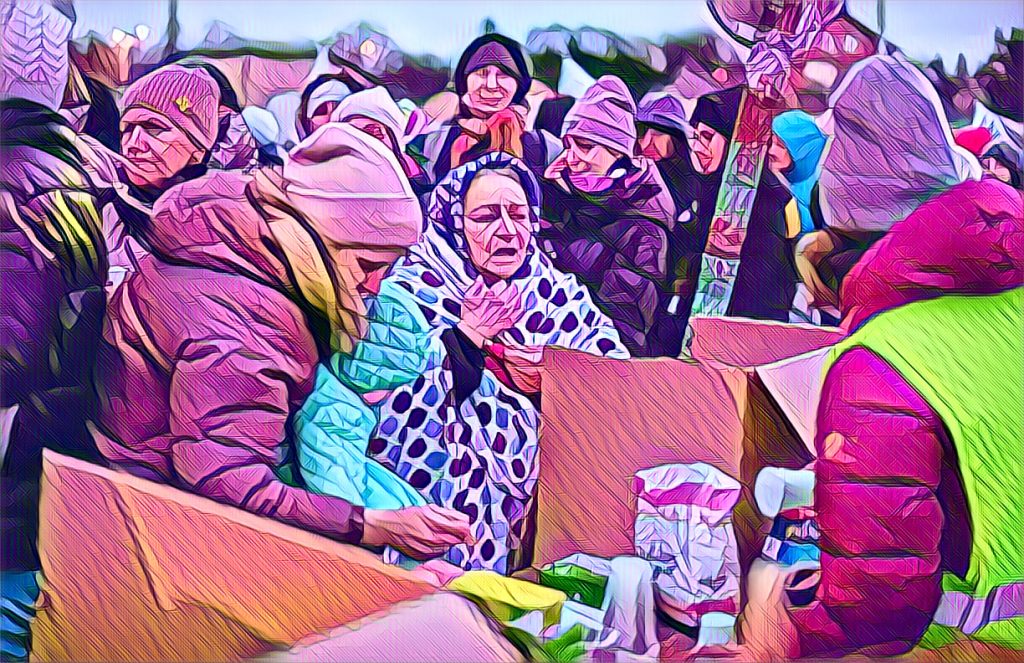The conflict in Ukraine has called into question many of the fundamental beliefs of the humanitarian aid industry in addition to creating a terrible humanitarian crisis. Through the prism of a conflict that has witnessed unprecedented levels of involvement from non-traditional actors and a dramatic shift in funding dynamics, the conventional paradigms of neutrality, impartiality, and the Western-centric model of assistance distribution are being examined closely.
The Ukraine Effect highlights a crucial moment in humanitarian aid, when questions are raised about the effectiveness of aid delivery. The conflict quickly escalated, requiring an equally prompt reaction that exposed long-standing inefficiencies and bureaucratic roadblocks in the aid system.
One of the most notable changes which is as a result of the Ukraine Effect is the increased emphasis on local actors in humanitarian response. Conflicts have exemplified how effective the role of local NGOs, volunteers and civic society groups can be in assisting people in need and by providing relief and support in emergency situations. These experiences demonstrated a different model that is reliant on local expertise and knowledge, which is a challenge to the traditional international aid organizations.
The question of neutrality, which is an underlying axiom of humanitarian aid, is becoming a factor which makes volunteering in the cause of Ukraine so complex. The independence of humanitarian organizations is put to the test when the funding generally comes from governing public sectors that usually have either direct or indirect interests in the conflict. Hence, ethical concerns arise about donors’ drive to attain the objectives of aid work and the willingness of humanitarian agencies to remain impartial.
Another problem that the Ukraine Effect has revealed the world is the uneven repartition of financial resources. The eye-opening financial aids provided to Ukraine have however diverted attention to the financial gap that exists in respect of crisis in regions that are not included or news-to-write about. This particular reason has unleashed the debate over how to achieve more egalitarian and needs-based distribution of the humanitarian assets.
Non-traditional humanitarian actors, including grassroots community groups and volunteers, have been the common butterfly enabling a Ukraine response unlike any other. These local volunteers have been acting as an alternative to the professionals who would normally facilitate development in the face of crises, and thus the importance of a community-based approach has been shown as quintessential to such situations.
Dispelling the myths surrounding aid is a good place to start when looking to accelerate reform. The Ukraine crisis has introduced a new class of non-conventional responders, from local volunteer brigades to grassroots communities, to become a more active part of the post-accident response. These changes have fundamental implications in the way actors are defined and to the funding which must be more responsive to the diversity of needs.
In addition to giving an indication of double standards in aid distribution, the occurrence of the crisis in Ukraine showed that this country received actual material assistance (in the form of a significant influx of funds) in comparison with the others affected by the crisis. To tackle this issue, the sector should uphold the fundamental principles of neutrality and bow to no one regardless of political significance, and aid should be distributed on a need basis rather than on the basis of politics.
The aid sector should, above all, apply the lessons from Ukraine to overcome the obstacles to the reforms and hasten the process. In this regard, one of the key concerns is to build up the capacity of the population in the area as they have been the front line in responding to the crisis. Addressing issues of timely delivery of funds to these actors and organizations, locally, means that aid could be more effective and relevant.
Moreover, the future of conflict will depend on finding the balance between the traditional tenets and the emerging tactical tools. This also covers the often complicated nature of neutrality in the face of political situations and the adjustment of the aid package to the social heterogeneity of the conflict areas which have a different socioeconomic background.

Developing a comprehensive aid plan that considers the diverse socioeconomic backgrounds of affected populations, including middle-class Europeans in the context of the Ukraine crisis. Promoting creativity and adaptability within the given aid sector as the latter adjusts to the unpredictability of disasters on the rise. This includes building data or information analysis systems to support prompt and efficient responses and creating aid management systems for better coordination. The Ukraine crisis has brought to light glaring disparities in the distribution of funds in the humanitarian aid sector.
Some emergencies get a lot of financing and attention, but others go unfunded and unnoticed. This discrepancy calls into question the fairness of aid allocation as well as the variables influencing funding choices. The Directorate General for European Civil Protection and Humanitarian Aid Operations (DG ECHO) of the European Commission distributes funds based on a needs-based methodology, taking into account a variety of factors like the magnitude of the disaster and the population in need.
On the other hand, the media’s prominence during a crisis may also help draw in more funding, which could result in imbalances. Non-traditional humanitarians in Ukraine, such as volunteer brigades, neighbourhood associations, and regional NGOs, have been essential to the response operations in Ukraine.
By challenging conventional ideas of humanitarianism, these individuals have demonstrated that successful aid can originate from sources other than the well-established organizations. Their participation has served as evidence of the value of local expertise and the capacity for quick decision-making in emergency situations.
Localization: Despite robust Ukrainian civil society, international agencies have struggled with localizing aid. Explore the ethical dilemmas and potential solutions.

In recent years, the idea of “localization” in humanitarian relief has gained popularity. It highlights the significance of local players in spearheading response operations. The idea behind localization is that local actors are in the best position to comprehend and respond to the demands of their communities in times of crisis. However, foreign organizations have had trouble handing over control of aid procedures to local bodies in Ukraine. This has given rise to ethical dilemmas including autonomy, equity, and the efficiency of aid distribution.
The conflict between the need to empower local actors and the need to offer large-scale, immediate aid is one of the main ethical dilemmas. Even though international organizations frequently possess greater resources and crisis management expertise, local initiatives may be overshadowed and local communities’ agency may be compromised by their actions. There’s a chance of developing dependencies that could impede rehabilitation and sustainability in the long run.
A further ethical consideration is how to distribute aid fairly. Local actors may distribute aid unevenly because of their prejudices towards particular communities. On the other hand, foreign organizations might not have the sophisticated knowledge necessary to distribute resources equitably, particularly in a population as complex and varied as Ukraine.
There are a few possible solutions to these dilemmas. In order to transfer resources and knowledge while upholding the autonomy of local players, international organizations should establish genuine collaborations with local organizations. This entails encouraging capacity-building projects and incorporating local leaders in decision-making procedures. Donors should also offer flexible funding so that local organizations can distribute resources based on changing needs rather than setting rigid requirements that might not be in line with reality on the ground.
Communities’ needs and preferences must be understood by agencies through active engagement. In order to keep assistance current and useful, this involvement should be continuous and flexible. International and local players alike need to pledge to operate with accountability and transparency. This involves being transparent about the standards for aid distribution as well as the channels for complaints and criticism.
Neutrality Challenges: The crisis in Ukraine questions traditional humanitarian concepts of neutrality. See how humanitarian actors navigate neutrality in complex conflict zones.

The concept of neutrality in humanitarian action has come into stark relief as a result of the continuing crisis in Ukraine. One of the guiding principles for humanitarian actors has historically been neutrality, which states that they cannot support one side in a conflict or get involved in disputes that are political, racial, religious, or ideological in nature. In humanitarian action, neutrality is meant to guarantee that relief organizations can function autonomously and give aid according to need, without bias. Gaining the trust of all sides involved in a conflict is also a technique of assuring safe access to affected populations.
Maintaining neutrality is challenging in Ukraine as it is in other complicated crisis. Humanitarian actors frequently encounter circumstances in which it is difficult to distinguish between military and civilian goals. For example, humanitarian agencies may face pressure from governments or armed groups to support their goals, and assistance convoys may be targeted or exploited for military objectives.
Furthermore, despite an organization’s best efforts to maintain neutrality, the intensely politicised atmosphere of such battles can give rise to charges of prejudice. This may jeopardise the safety of their employees and damage the credibility of humanitarian actors.
Humanitarian actors have implemented a number of techniques to deal with these obstacles. Humanitarian organizations can negotiate access and promote the respect of humanitarian values by interacting with all sides involved in the conflict. This is one of their techniques. Maintaining a fine balance is necessary to avoid having this involvement come across as picking a side. Parties to the conflict as well as the impacted populations must be informed in a clear and concise manner of the organization’s mission and the values that direct its operations.
Their openness contributes to the growth of comprehension and acceptance of their impartial position. International humanitarian law offers a legal framework for humanitarian actors to retain their neutrality, which they must scrupulously abide by. These includes abstaining from actions that can be interpreted as endorsing one party in the dispute. Humanitarian organizations work hard to maintain a variety of independent funding sources in order to prevent the appearance of bias. This lessens the possibility of coming out as swayed by the political agenda of any specific donor.





2 comments
Reading your article helped me a lot and I agree with you. But I still have some doubts, can you clarify for me? I’ll keep an eye out for your answers. Bonus Referal Binance
Can you be more specific about the content of your article? After reading it, I still have some doubts. Hope you can help me.